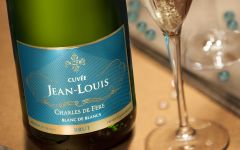Charles de Fere Cuvee Jean-Louis Ice Blanc de Blancs




Product Details
Your Rating
Somm Note
Winemaker Notes
Pale yellow color. Fine and elegant bubble line. Expressive notes of candied fruit, white flowers and a hint of citrus to the nose. Supple and light mouth, slightly sweet, both fresh and fruity, revealing flavors of white peach. Cuvee Jean-Louis ICE blanc de blancs is much like the splendorous city of Paris: bustling, sparkling, decadent and perfect at any time, day or night.
Pouring this wine over ice ignites its dynamic and fruity personality. This bubbly coalescence of fire and ice in the glass will not stay secret for very long.
*The label for this wine has recently changed. Customers may receive either bottle featured above. Specific labels cannot be requested.




Charles de Fère came to life in 1980 when an innovative sixth generation winemaker from Champagne, Jean-Louis, decided to start his own sparkling winery in a town called Fère-en-Tardois, just outside Champagne. Named in his honor, Cuvée Jean-Louis embodies his audacious vision of crafting high-quality sparkling wines from grapes grown throughout France, strongly believing that a more diverse sourcing strategy would allow him access to the best possible grapes each year. Northern vineyards brought freshness and elegance, while southern vineyards provided beautifully ripe fruit, body and smoothness to the wines. In honor of his son Charles, he named his winery Charles de Fère, meaning "Charles from Fère."
Today, Charles de Fère wines are crafted in Burgundy at the Boisset family's state-of-the-art sparkling wine facility. True to its roots, Charles de Fère’s grapes continue to come from diverse terroirs throughout France, ensuring the best possible fruit for consistently excellent sparkling wines at a great value.

Appreciated worldwide as an iconic token of celebration and luxury, sparkling wines from France come in more forms than just Champagne. In order to bear the label, ‘Champagne’, a sparkling wine must originate from the northeastern region of France—called Champagne—and adhere to strict quality standards. Champagne’s chalky, limestone and soils and cold, continental climate create grapes with ample acidity and concentration. Chardonnay, Pinot Noir, and Pinot Meunier are permitted for use in Champagne.
French sparkling wines made outside of Champagne take the name Crémant. Crémant de Bourgogne, Alsace, Loire and Limoux are the best known. These are made using the same technique as that of Champagne, called méthode traditionelle, but typically are composed of the regional grape variety. Usually dry to off-dry with bright acidity, these are often characterized by qualities of lemon, peach, marzipan and white flowers.
